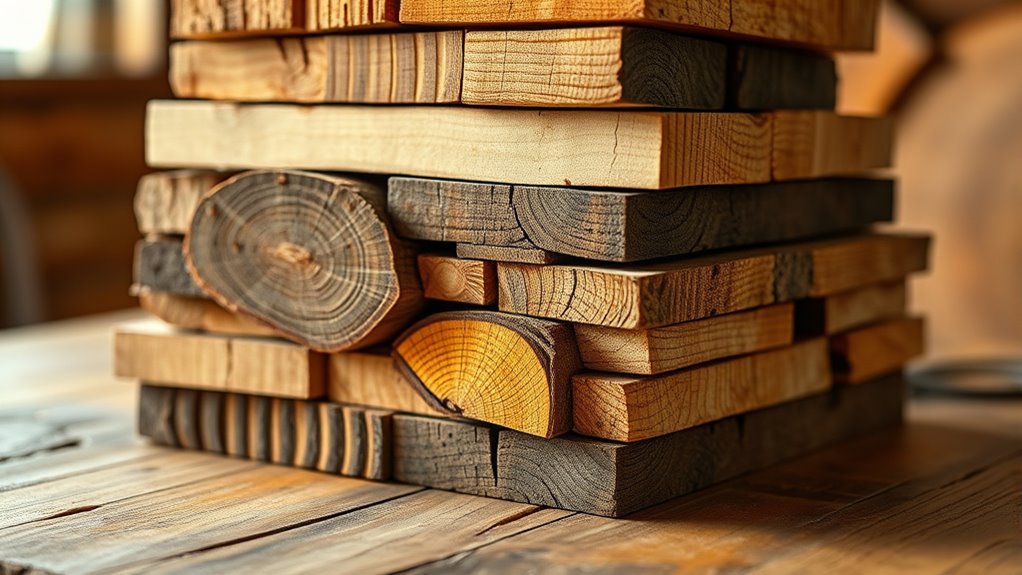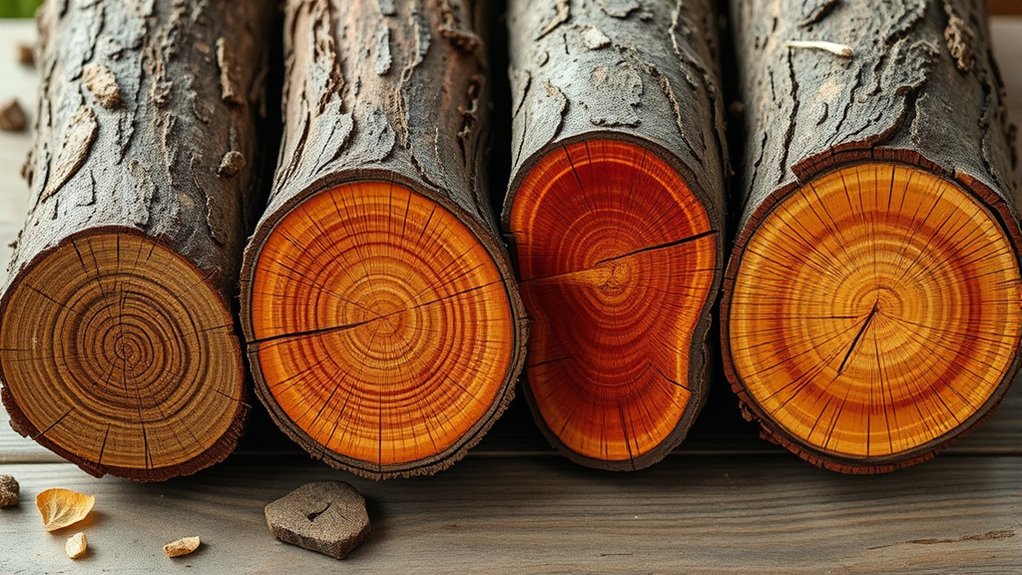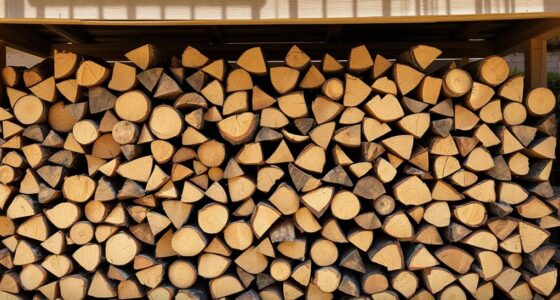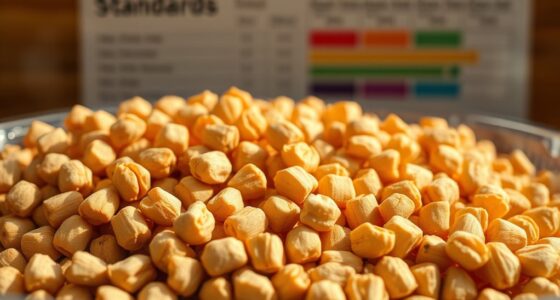Hardwoods like oak, hickory, and beech offer the highest energy density, meaning they produce more heat when burned compared to softwoods like pine or cedar. Their denser cellular structure allows for more compact fibers, leading to greater calorific value. Selecting these woods guarantees longer-lasting, more efficient heat output. If you want to learn which specific wood species maximize energy and how harvesting methods affect performance, keep exploring these factors further.
Key Takeaways
- Hardwoods like oak, hickory, and beech generally have higher energy densities than softwoods.
- Denser wood species produce more heat per volume due to their compact cellular structure.
- Properly dried (low-moisture) wood enhances combustion efficiency and heat output.
- Hardwood species typically have higher calorific values compared to softwoods.
- Sustainable harvesting and storage practices maximize the energy potential of high-density wood.

Ever wonder how different wood species compare in their ability to store energy? The key factors that influence this are the wood’s energy density, which is how much heat it produces when burned, and the way it’s harvested and prepared. Sustainable harvesting practices are vital because they guarantee you’re not depleting forests or damaging ecosystems in the process. When selecting wood for fuel, it’s also essential to consider the wood moisture content, as it directly impacts energy output. Wood with low moisture content burns more efficiently, releasing more heat and producing less smoke and creosote buildup.
Choosing sustainably harvested, low-moisture wood enhances energy output and reduces environmental impact.
In terms of energy density, hardwoods generally outperform softwoods. Hardwoods like oak, hickory, and beech pack more energy per unit volume because their cellular structure contains denser, more compact fibers. These woods tend to have higher calorific values, meaning they produce more heat when burned compared to softer woods like pine or cedar. However, the actual energy output isn’t just about the species; it’s considerably affected by how the wood was harvested and stored. Properly harvested wood that’s dried sustainably and stored correctly will have lower moisture content, which maximizes its energy potential.
Additionally, the type of wood, its density, and how it’s prepared before burning all influence the energy density. While hardwoods generally produce more heat, they can also be denser and harder to split, requiring more effort during preparation. Softwoods, although less energy-dense, ignite quickly and are easier to handle, making them popular for quick heating needs. Still, for long-lasting heat output, hardwoods are usually the preferred choice, especially when harvested responsibly.
Moreover, the use of proper storage techniques can significantly improve the energy density of firewood by ensuring it remains dry and ready for efficient combustion.
Frequently Asked Questions
How Does Moisture Content Affect Wood’s Energy Density?
Moisture content substantially affects wood’s energy density because higher moisture reduces the heat output during combustion. When you dry wood through the drying process, it lowers the moisture impact, allowing more energy to be released as heat. Wetter wood burns less efficiently and produces less heat, so ensuring proper drying maximizes energy density. You’ll get more heat and cleaner burns when you use well-dried, low-moisture wood.
Which Wood Species Burn the Cleanest?
You’ll find that hardwoods like oak and maple burn the cleanest, producing lower emission levels and better air quality. These species tend to have dense, dry wood that releases fewer pollutants when burned. To minimize your environmental impact, always use well-seasoned wood and guarantee your stove or fireplace operates efficiently. Choosing the right wood not only improves air quality but also provides a cleaner, more sustainable fire experience.
How Does Wood Density Relate to Heat Output?
Think of wood density as a packed treasure chest; the more tightly compressed, the more heat it holds. You’ll see this through wood compression and density testing, which reveal that denser woods pack more energy per volume. When you choose high-density wood, you’re fundamentally selecting a fuel that burns longer and hotter, making it ideal for maximizing heat output. Density directly correlates with the amount of heat your fire can produce.
Are There Environmental Concerns With High-Energy Woods?
Yes, using high-energy woods can raise environmental concerns. You should guarantee sustainable harvesting practices to avoid depleting forests and to reduce deforestation impacts. Overharvesting increases habitat loss and carbon emissions, harming ecosystems. By choosing sustainably sourced wood, you help minimize these issues, promoting responsible use. Always verify that your wood comes from well-managed forests to enjoy high heat output without contributing to environmental degradation.
Can Energy Density Vary Within the Same Wood Species?
Yes, energy density can vary within the same wood species due to moisture variability and other factors. When wood has higher moisture content, it produces less heat because energy is used to evaporate water. Additionally, differences in growth conditions, age, and part of the tree can influence energy density. So, even within a species, you might see some variation in heat output depending on these factors.
Conclusion
Think of choosing a wood species like selecting a treasure chest—some hold more riches than others. If you want the most heat for your fire, go for those with the highest energy density, like certain hardwoods. They’re the secret stash that burns longer and hotter, turning your woodpile into a mighty furnace. So, when you’re ready to ignite your fire, remember: not all wood is created equal—some are true kings of heat, waiting to be unsealed.











